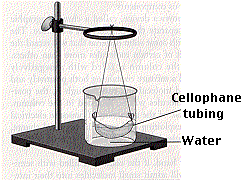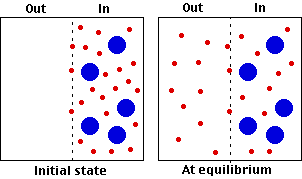Mixtures and Compounds

Mixtures are heterogeneous forms of matter. Mixtures are composed of variable proportions of molecules and atoms.
Compounds are homogeneous forms of matter. Their constituent elements (atoms and/or ions) are always present in fixed proportions (1:1 depicted here).
Examples of mixtures:
Examples of compounds:
- water (H2O)
- table salt (NaCl)
- table sugar (C12H22O11)
Properties of Mixtures
- The composition of a mixture is variable.
- Each of its components retains its characteristic properties.
- Its components are easily separated.
Properties of Compounds
- The relative proportions of the elements in a compound are fixed.
- The components of a compound do not retain their individual properties. Both sodium and chlorine are poisonous; their compound, table salt - NaCl - is absolutely essential to life.
- It takes large inputs of energy to separate the components of a compound.
Separating the Components of a Mixture
 Most laboratory work in biology requires the use of techniques to separate the components of mixtures. This is done by exploiting some property that distinguishes the components, such as their relative
Most laboratory work in biology requires the use of techniques to separate the components of mixtures. This is done by exploiting some property that distinguishes the components, such as their relative- size
- density
- solubility
- electrical charge
Dialysis is the separation of small solute molecules or ions (e.g., glucose, Na+, Cl-) from macromolecules (e.g., starch) by virtue of their differing rates of diffusion through a differentially permeable membrane.

An example:
Cellophane is perforated with tiny pores that permit ions and small molecules to pass through but exclude molecules with molecular weights greater than about 12,000. If we fill a piece of cellophane tubing with a mixture of starch and sugar and place it in pure water, the sugar molecules (red dots) will diffuse out into the water until equilibrium is reached; that is, until their concentration is equal on both sides of the membrane. Because of their large size, all the starch (blue disks) will be retained within the tubing.
Chromatography
Chromatography is the separation of the components of a mixture by their differential adsorption to an insoluble matrix (e.g., paper) as the mixture passes through the matrix.
Electrophoresis
Electrophoresis uses a direct electric current to separate the components of a mixture by the differing electrical charge.
Pure Substances
Some of the pure substances isolated from mixtures cannot be further broken down. Oxygen (O2) is an example. It is one of the elements; the fundamental building blocks of matter.
Most pure substances are compounds. Table salt, sodium chloride (NaCl) is an example, water (H2O) is another. If we pass an electrical current through molten NaCl, two new substances will be formed:
- sodium, a shiny metal so reactive that it must be stored out of contact with the air
- chlorine, a yellowish poisonous gas.
In this operation, a compound has been decomposed into its constitutive elements.
Note the differences between separating the components of a mixture and those of a compound.
- The decomposition of NaCl required a large input of energy. This is because of the strength of the ionic bonds holding the Na and Cl atoms together.
- The ratio of the weights of the two products are always 23 parts of sodium to 35.5 parts of chlorine. This reflects:
- the invariance of the ratio (1:1 in this case) of the number of atoms in a compound
- the relative weights (23:35.5) of the atoms in table salt.
- The properties of the components of the compound are not the same as those of the compound itself. Both sodium and chlorine are hazardous to life; their compound, sodium chloride, is a vital ingredient of all animal diets.
7 September 1999

 Most laboratory work in biology requires the use of techniques to separate the components of mixtures. This is done by exploiting some property that distinguishes the components, such as their relative
Most laboratory work in biology requires the use of techniques to separate the components of mixtures. This is done by exploiting some property that distinguishes the components, such as their relative